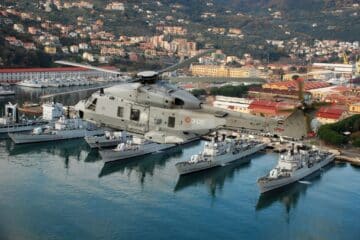No further details were delivered about the contract scope with the joint statement of the two companies released on 14 March, but Naval News understands it was awarded in late December 2023, and as reported on the EU restricted tender, it includes design, construction and delivery of the four TIRMA, integrated logistical support (as well as temporary support) activities lasting three years for each vessel, services and supplies upon request, as well as upgrading activities for infrastructural accommodations in the Port of Leghorn. According to the tender notice, the contract value is almost 72 million euros, of which just over two million euros regards the infrastructural upgrades and the services and supplies on request.
Intended for personnel familiarization undergoing training at the Naval Academy with the ship environment, acquisition of seamanship skills from basic to advanced level, in the kinematic and mooring manoeuvres of naval units as well as in safety matters, these vessels will also be used as reported in the documents in the tender, to carry out the practical activity foreseen in the process for obtaining the basic level “Bridge Watch” qualification. This to acquire the knowledge and skills for the conduct of safe navigation according to criteria defined by the International Convention “Standards of Training, Certification and Watchkeeping for Seafarers” (STCW) where applicable for the military.
These vessels will fill a capacity gap which was created when the last of three Aragosta class auxiliary units (Astice, Murena and Porpora), former coastal non-magnetic minesweepers modified for prevalent use in supporting the training of cadets and officers attending the Naval Academy, were withdrawn from service in December 2019.
Characterized by work and living spaces functional to recreating environments similar to those of the in-service ships, according to the contracting companies press statement, the TIRMA units will have high living standards with accommodation, logistical and operational solutions that will support a crew of 24 personnel divided between four permanent crew units and a maximum of 20 personnel from the teams in training.
The contracting companies haven’t disclosed details about these 33 m steel units, but from the tender documents, they should have a maximum width and construction height of 8.4 and 3.8 m respectively, a maximum draft less than 2.7 m and a full load displacement of approximately 170 tonnes.
The new units will be able, according to the tender documents, to operate in “Sea State 3” conditions and to carry out manoeuvres in restricted and shallow waters (3/4 metres) at slow speeds and without the assistance of tugboats. Equipped with equipment and systems mainly of commercial origin, according to the tender, the new units will be equipped with a propulsion system centred on two diesel engines connected to the same number of shaft lines with adjustable blade propellers capable of developing a maximum speed of 15 knots , according to the contracting companies. The endurance must be equal to 1000 nautical miles at 11 knots while the logistical autonomy must be equal to at least 4 days with the personnel on board.
The image disclosed by the contracting companies shows a vessel with reduced draft with bow thruster and double shaft lines, with a large free area at the stern and superstructures used as accommodation and logistics areas with an operational bridge above with 360° windows and mast with systems for navigation, communications and surveillance around the ship. The latter has also the capability to embark a tender.
The new TIRMA vessels, according to the tender documents, will have to ensure all seamanship maneuvers according to Italian Navy and IMO standards, as well as provide emergency towing to all ships of similar displacement. They must be able to ensure suitable Command, Control, Communications and Computer functions using non-classified systems for the real-time management of ship activities carried out from the bridge and wheelhouse stations. The vessel design must ensure an operational life cycle of no less than 30 years and must ensure a technical availability of no less than 80% and an operational availability on mission of no less than 85%. In addition to the supply of the four vessels, as highlighted in the tender notice, the contract also includes the related Integrated Logistic Support (ILS) and Temporary Support (TS) for a period of three years for each platform. Added to these is also the infrastructural upgrade work at military accommodating facilities on the Medici Pier, at the Port of Leghorn.






